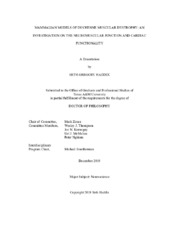| dc.description.abstract | Duchenne muscular dystrophy (DMD) is muscle wasting disease that leads to early mortality in humans. It results from the absence of the protein dystrophin at the membrane, specifically the contractile cells of skeletal and heart muscle. Due to the lack of dystrophin, skeletal and cardiac myocytes have an increased susceptibility to contraction-related injury, bringing about cycles of degeneration and regeneration. With disease progression, regeneration fails and muscle is replaced by fibrotic and adipose tissue, which ultimately leads to muscle weakness. Investigations of skeletal muscle in DMD have generally ignored the neuromuscular junction (NMJ). The synapse is essential in proper skeletal muscle contraction. The NMJ in dystrophy is abnormal. The synapse forms non-continuous “islands” or fragments as compared to normal pretzel-like structures. Whether these fragmented NMJs are causative in disease progression has yet to be resolved and may represent a therapeutic target for disease amelioration. My studies extend understanding of DMD models by investigating the NMJ abnormalities in dystrophic mice and dogs, as well as cardiac muscle function in the former.
The work in presented provides a comprehensive description of NMJ morphological features in mdx, a murine DMD model, and golden retriever muscular dystrophy (GRMD), a canine model. Using confocal microscopy, I compare the normal architecture and pathophysiology of diseased NMJs to normal. Junction structural changes are progressive with age in mdx, paralleling overall disease progression and severity and are similar to GRMD synapses. Using a technique that measures the replacement of acetylcholine receptors (ACHRs) via their in vivo labeling, I show that receptor replacement is correlated with NMJ remodeling. I also report that dystrophic NMJ remodeling is initiated by muscle injury near the synaptic area. Isometric contraction force recording measurements of various muscles in geriatric mdx mice suggests that contractile function is unperturbed even in the face of synaptic remodeling. The cardiac function, as assessed by echocardiography and speckle tracking is dysfunctional in geriatric mdx hearts. I conclude that arresting NMJ remodeling caused by muscular dystrophy is not a viable therapeutic approach, but that the process is likely held in all mammals that lack dystrophin, including DMD boys. | en |


